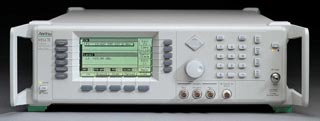
|
|
The Anritsu 69167B 40 GHz Ultra Low Noise Synthesized Signal Generator features 10 MHz to 40 GHz analog, step, and manual sweep capability. The 69167B also provides AM/FM/pulse modulation via external modulating signals. Output levels to +17 dBm and optional 0.1 Hz resolution are available at prices comparable to CW-only sources. To meet requirements that expand over time, economical upgrades are available to any higher performing model. Features, performance, and value combine to make the 69167B the optimum source for your network analysis and swept A.T.E. source applications. Specifications. Frequency range: 10 MHz to 40 GHz (Optional frequency extension down to 0.1 Hz). CW mode Output: Twenty independent, presettable CW frequencies (F0 to F9 and M0 to M9). CW mode Accuracy: Same as internal or external 10 MHz time base. CW mode Internal time base stability: With aging; <2 x 10–8/day (<5 x 10–10/day with Option 16), With temperature; <2 x 10–8/°C over 0°C (<2 x 10–10/°C with Option 16). CW mode Resolution: 1 kHz (0.1 Hz with Option 11). Analog Sweep width: Independently selected from 1 MHz to full range continuous sweep. Analog Sweep Accuracy: The lesser of ±30 MHz or (±2 MHz widths) for sweep speeds of <=50 MHz/ms. Output power: +13 dBm (+11 dBm with attenuator) >= 0.01 to < 2 GHz, +9 dBm (+7 dBm with attenuator) >= 2 to <= 20 GHz, +6 dBm (3 dBm with attenuator) > 20 to <= 40 GHz. Minimum leveled output power range: -20 dBm, (-120 dBm with attenuator). Output power resolution: 0.01 dB (log) or 0.001 mV (linear). Option 1 Rack mounting. Option 2B 110 dB step attenuator. Option 9 Rear panel RF output. Option 11 0.1 Hz frequency resolution. Option 15A High power output. Option 16 High stability time base. Option 17A Delete front panel. Option 18 mmWave bias output. Option 19 SCPI programmability. Option 21 High spectral purity down converter. Option 22 0.1 Hz to 10 MHz audio frequency.
|